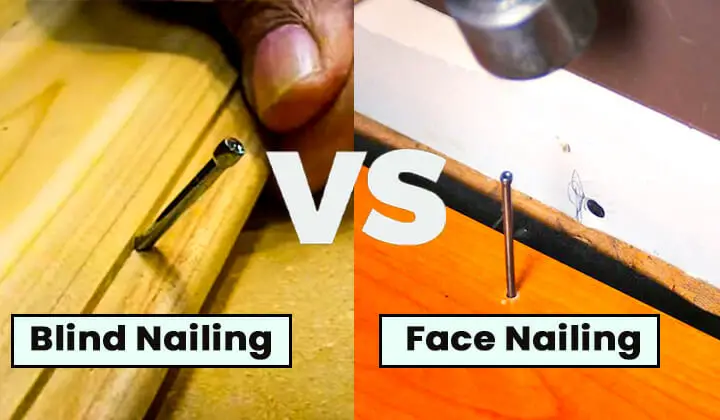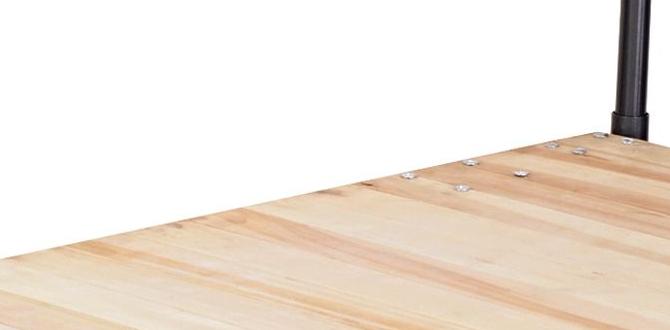Face nailing is the technique that is commonly used when we think about nailing. But there are other categories of nailing too. Blind nailing is when you nail a nail at an angle then cover it with some other part of the wood in order to conceal it from any external site. Both of them have different uses in different projects.

Table of Contents
Blind Nailing vs Face Nailing- Which One Is Better?
There is no definitive answer as to which one is better. It depends on the project and what it is used for. As a general rule of thumb, face nailing is a bit stronger than blind nailing and used where it doesn’t matter if the nail head can be seen.
On the other hand, blind nailing is used when it is a decorative work, and the nail head would hinder the beauty. It can often be a bit less intense than face nailing, but it shouldn’t be much of a problem if used correctly.
The key to finding which one is better is to know how to use them and find out which will work better for the project you are doing. So here, we will discuss how to use both methods and possibly the best place for them to get you a better idea, hopefully. Well, that would provide enough hints to identify your need in your work.
Face Nailing
Face nailing is the usual method of nailing that we all know. Simply put the nail on a 90-degree angle to the wood and use a hammer or nail gun to nail it in. It is easy to do and keep things secured in place better than blind nailing.

In this approach, the nail head remains exposed, which can be covered using some paints. But if you are doing decorative work, these exposed nails can be a bit of a problem. So it is typically used in places where you do not need to hide the nail head.
Where to Use Face Nailing?
Some examples of them can be when installing trim around the wall edges on door or window frames. They need to be secured, and often the nails can be out of sight or covered with paint- both possible. It also makes them more secure to the wall. So face nailing is an excellent choice to use here.
Other examples can be when building stairs or doing flooring. These are often utilized with face nailing. Stairs need to be strong enough to hold weight and for daily use. So face nailing works better. As for flooring, face nailing provides a better joint and stronger hold on the floor.
Blind Nailing
Blind nailing is a technique that is standard and used widely. You will see it if you pay close attention. It is often overlooked because it is blind nailing and cannot be seen from the outside. Unless you know about it, you cannot figure it out.
Blind nailing is most commonly used with a groove and tongue-style joint. You can do your nailing at a 45-degree angle on the tongue and slide the groove in to conceal the nail.
How to Do Blind Nailing?
For blind nailing, only a nail and hammer are not enough. You need to have a nail pusher push the nail head all the way in without damaging the tongue, or else it will hinder the groove placement.
First, place wood on the surface where you want to nail it. Then take a nail and place it around a 45-degree angle on the tongue of the wood.

Now hammer it until you cannot hammer the nail safely without damaging the wood. Now use a nail set and place it on the nail’s head. Then strike the nail set to bury the nail head inside the tongue.

After the nail head goes down on the same level as the wood surface, you can slide the groove into the tongue and repeat the process as many times as necessary.

Where Do I Use Blind Nailing?
Most of the modern hardwood floor these days uses blind nailing. You can also use blind nailing for a tongue and groove ceiling. Beadboard is an excellent way to decorate any wall, and you do not want any nails to stick out and ruin the decoration. So they also use blind nailing.
You can say the same thing about shiplap too. They also use blind nailing for beauty purposes. Another thing that can use blind nailing is the decorative molding that is used in many houses.
So, In general, any decorative work usually uses blind nailing. That way, it makes sure that the nails are out of sight and the work remains beautiful to look at. But that doesn’t mean you can’t use blind nailing for non-decorative works too. But it is better to use face nailing if you do not need the technique of blind-nailing.
Frequently Asked Questions (FAQ)
1. How to hide nails?
Ans: You can hide nails by doing blind nailing.
2. Do you nail the tongue or groove?
Ans: You need to nail the tongue at a 45-degree angle and do blind nailing.
3. Can I always use blind nailing?
Ans: In some places, building code prevents it from using blind nailing. Other than that, you can usually use blind nailing, excluding the places that always need face nailing.
4. What is a blind nail used for?
Ans: Blind nailing is used in trims, molds, and decorative items generally.
Conclusion
Face and bind nailing both have their use in the work. It is impossible to say one is better than the other, in this case. You simply have to learn which one is the best for your work and use that for a better result.
Also Read: Creative nail gun storage ideas

